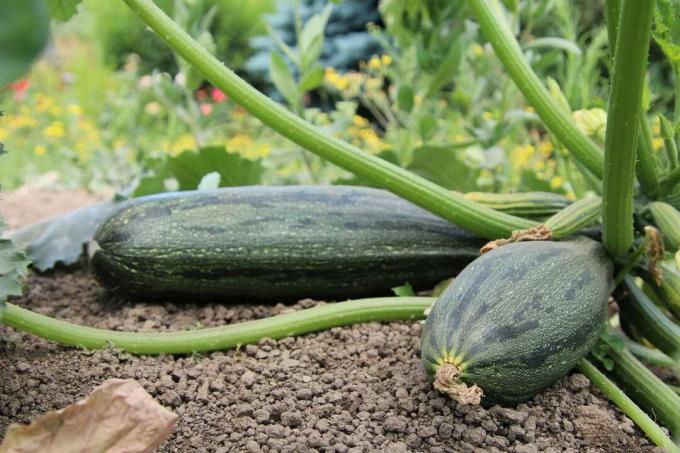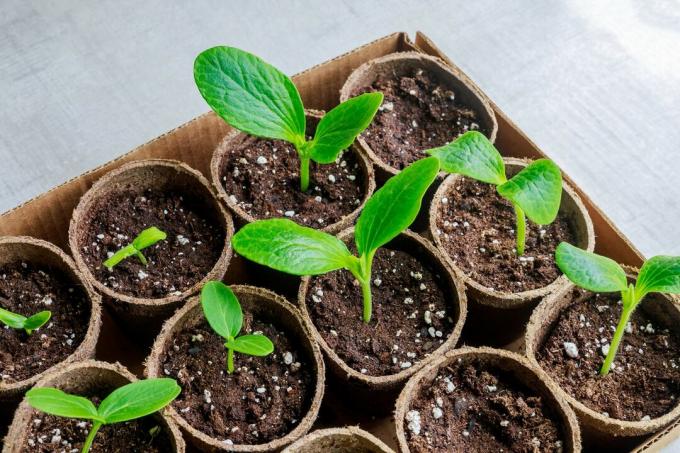
Cucurbits produce many fruits during the summer. Cultivation is always worthwhile. The plants grow very quickly after sowing. It is then necessary to separate the seedlings. Instructions on how to prick zucchini can be found here.
In a nutshell
- Prick out seedlings with a pair of leaves
- tolerate a deeper setting in the pot
- lower leaves must not touch the ground
- transplant into 9 to 15 cm pots
- Use high-quality potting soil such as vegetable soil
Table of contents
- Pricking out stimulates growth
- Prick the zucchini – instructions
- frequently asked Questions
Pricking out stimulates growth
After the seeds emerge, the young seedlings are usually very close together. When pricking out or separating, the seedlings are then transplanted at greater distances, usually individually into correspondingly large pots.

Advantages
- Stimulating root growth
- Development of healthy and strong plants
- Growth stimulus for seedlings
Pricking out young zucchini (Curcurbita pepo) seedlings is also important for a good harvest. The seedlings can be separated when they are about five centimeters high and the first pair of leaves has developed. The young plants can be planted deeper in the pot. However, the lowest leaves must not rest on the ground. Otherwise rotting can quickly occur. Putting the seedlings deeper into the pot leads to
- stronger stems and
- to additional root formation.
Tip: The zucchini can also be sown individually in large pots. Then pricking is no longer necessary.
Prick the zucchini – instructions
At the pricking care must be taken to avoid crushing the delicate plants by their stems and roots.

aids
- a pricking set consisting of a pricking stick and a pricking fork/shovel
- alternatively a spoon, cake fork or a wooden skewer
more utensilsand materials
- corresponding number of pots with a diameter of 9 to 15 centimeters
- nutrient-rich substrate such as tomato or vegetable soil
- this contains a high proportion of nitrogen, phosphorus and potassium
Once all the preparations have been made, you can get to work:
- Fill pots halfway with soil
- Carefully remove the seedling from the seed tray
- to do this, slightly lift the root ball with a pricking shovel
- Hold the young plants by the leaves
- then put in pot
- fill up soil
- Leave the pouring edge
- Press the substrate lightly
- Roots get good ground contact
- pour well at the end

The soil must now be kept moist, but not wet, for the next few weeks. The plants get a light and warm place on the windowsill. To harden them off, they can move to a shady place outdoors during the day when temperatures are frost-free and warmer. In the evening they are brought back into the house.
A notice: The Zucchini is sensitive to frost. For this reason, it is not transferred to the open air until mid-May after the ice saints.
frequently asked Questions
The gourd will in the house from mid-April. This can be done in small pots or seed trays. The substrate should be low in nutrients. Cultivation soil is best suited. The seeds are placed two to three centimeters deep in it. A temperature between 18 and 20 degrees Celsius is optimal for germination. The soil must be kept moist but not wet. After about 7 to 10 days, the first seedlings are visible. Alternatively, you can sow directly outdoors from mid-May.
A zucchini plant needs a lot of space, at least one square meter per plant. The distance between the individual plants must also be at least one meter. Since the zucchini is a heavy feeder, the soil should be enriched with mature compost before planting. The young plant is then used to just below the base of the first leaves and the soil is well pressed and watered. Be careful not to injure the stem. The subsequent application of a mulch layer of grass clippings is advantageous.
The zucchini loves a sunny, warm and sheltered place. The pumpkin plant does not make any great demands on the soil. It should only be well drained, loose, rich in humus and nutrients and of medium weight and have good water retention. In addition, the zucchini can also be cultivated in a bucket. On the balcony and terrace it should be given a place facing south. The plant also thrives in a raised bed filled with manure and compost.
